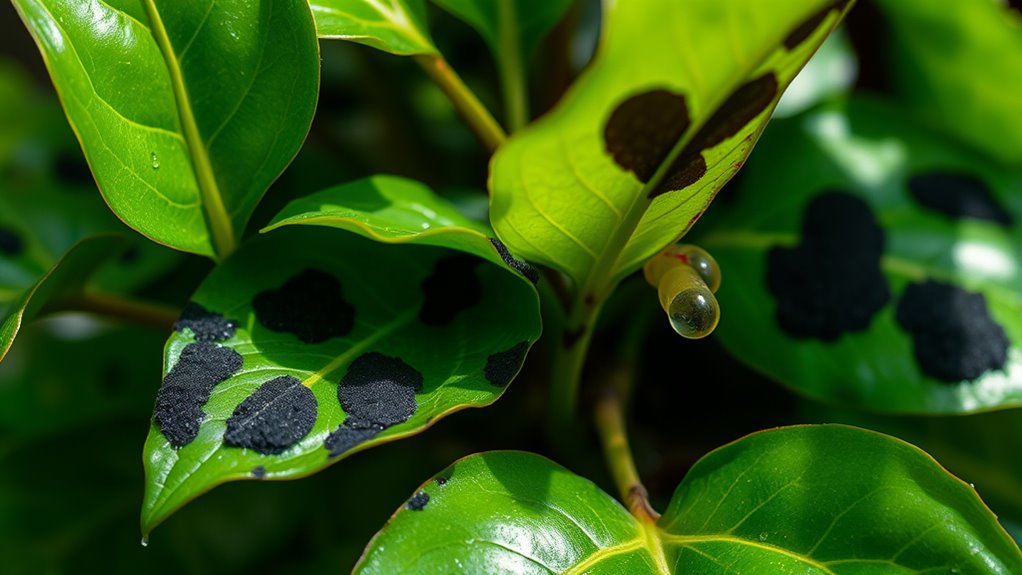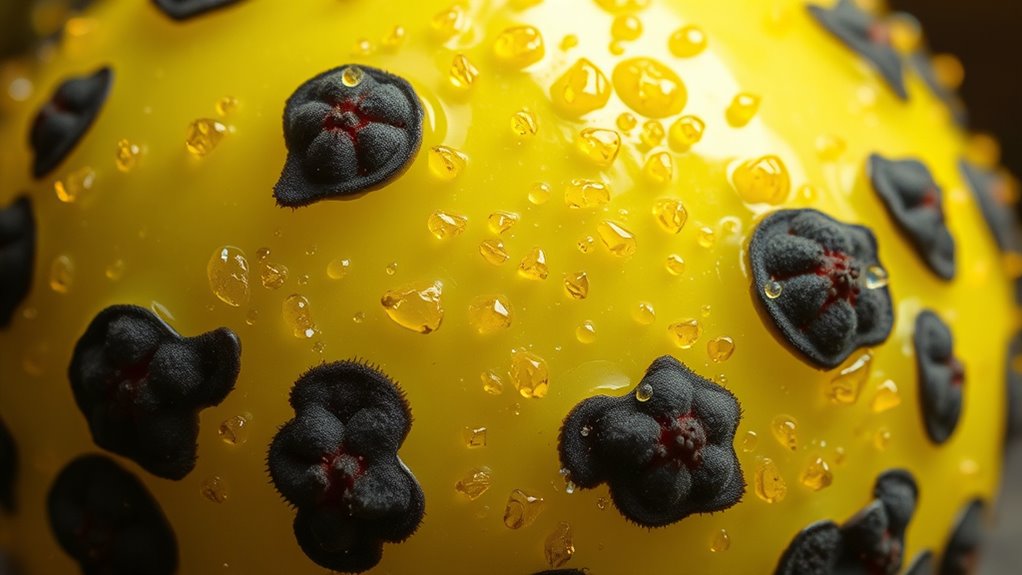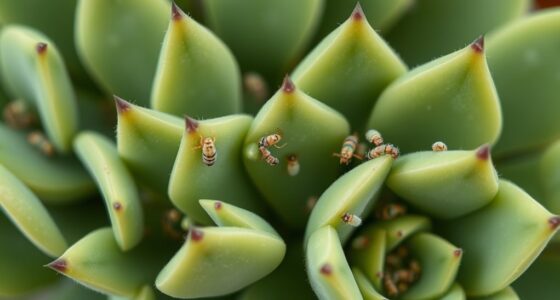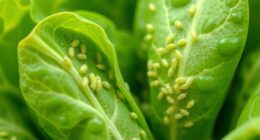If you notice sticky honeydew and sooty mold indoors, it’s likely caused by pests like aphids or scale insects feeding on your plants, leaving behind sugary residue that promotes black mold growth. To fix this, inspect your plants and surfaces, then wash affected areas with water mixed with mild soap or neem oil for natural pest control. Keep your environment clean and well-ventilated to prevent future issues. Continuing will reveal simple strategies to manage these problems effectively.
Key Takeaways
- Identify pest sources like aphids or scale insects causing honeydew buildup indoors.
- Use natural remedies such as neem oil or mild soap solutions to clean affected surfaces.
- Introduce beneficial insects like ladybugs indoors to control pest populations naturally.
- Improve indoor air circulation and reduce humidity to prevent mold growth on honeydew residues.
- Regularly inspect and remove infested plants or surfaces to prevent sooty mold spread.

If you notice a sticky, shiny film on your indoor surfaces, it’s often caused by honeydew secreted by pests like aphids or scale insects. This sugary substance coats leaves, furniture, and walls, creating an environment where sooty mold can thrive. The mold appears as black, powdery patches that tarnish the look of your plants and surfaces. While it might seem overwhelming, understanding how to manage this problem can help you keep your space clean and healthy.
One effective approach involves encouraging beneficial insects into your home. These natural allies, such as ladybugs and lacewings, feed on pests like aphids and scale insects, reducing their numbers without the need for harsh chemicals. By introducing or attracting these beneficial insects, you can naturally control the pests that produce honeydew, thereby decreasing the source of the problem. For example, releasing ladybugs into your indoor garden or keeping plants that attract them nearby can considerably cut down pest populations. This method not only helps eliminate pests but also promotes a balanced, eco-friendly environment inside your home.
Alongside beneficial insects, natural remedies play a crucial role in tackling honeydew and sooty mold. You can start by gently washing affected surfaces with a mixture of water and mild soap or neem oil. Neem oil acts as a natural insecticide, suffocating pests without harming beneficial insects or your household environment. Applying neem oil directly onto infested plants can control pests at their source, preventing honeydew from accumulating and mold from spreading. Additionally, regularly wiping down surfaces with a damp cloth helps remove honeydew before it allows mold to establish itself. Combining these natural remedies with good hygiene practices can keep your indoor spaces free from sticky residues and mold buildup.
Monitoring your plants and surfaces is essential. Check regularly for signs of pests or mold, especially if you notice a sticky film or black patches. Removing affected leaves or wiping down surfaces prevents the spread of mold and discourages pests from returning. Ensuring proper air circulation and reducing excess moisture also hampers mold growth, making your home less hospitable for mold spores and pests alike.
Frequently Asked Questions
Can Sticky Honeydew Harm My Indoor Plants?
Yes, sticky honeydew can harm your indoor plants. When honeydew covers leaves, it encourages sooty mold growth, which can block sunlight and interfere with photosynthesis. Honeydew damage can also cause leaf decay and promote mold, weakening your plants’ health. Over time, the plant’s overall vigor diminishes, leading to poor growth or even death. Regular cleaning and pest control help prevent honeydew buildup and protect your plant’s health implications.
Is Soot Mold Toxic to Humans or Pets?
Think of soot mold as a silent thief in your home. It’s not directly toxic, but the spores it releases can cause allergic reactions or respiratory issues for you and your pets. While the mold isn’t inherently toxic, the presence of toxic spores makes it wise to clean it promptly. Breathing in these spores can lead to discomfort or health problems, so regular removal is essential for a safe indoor environment.
How Often Should I Clean Soot Mold Indoors?
You should clean soot mold indoors at least once a week to prevent it from spreading and affecting your health. Improving air circulation helps reduce mold accumulation, so open windows or use fans during cleaning. Regular cleaning frequency is key—more often if you notice increased soot or mold growth. Use proper cleaning solutions and wear protective gear to guarantee thorough removal and maintain a healthy indoor environment.
Are There Natural Remedies to Remove Honeydew Stains?
Like a true Renaissance artist, you can use natural remedies for stain removal. Mix equal parts of white vinegar and water, then apply it to honeydew stains. Let it sit for a few minutes before scrubbing gently with a soft cloth. Baking soda paste is also effective—combine baking soda with a bit of water to create a thick paste, then apply and scrub. These eco-friendly methods help remove honeydew stains naturally.
Does Indoor Humidity Affect Sooty Mold Growth?
Yes, indoor humidity levels directly influence sooty mold growth. High humidity creates an ideal environment for mold to thrive, so maintaining proper indoor humidity is essential for mold prevention. Keep humidity levels between 30-50%, use dehumidifiers if needed, and ensure good ventilation. By controlling indoor humidity, you reduce the chances of sooty mold developing and keep your indoor environment healthier and cleaner.
Conclusion
To tame the sticky honeydew and soot mold indoors, you must act swiftly—like a gardener tending delicate blooms before they wither. Regular cleaning, reducing humidity, and inspecting plants can prevent these issues from taking root. Remember, neglect is a silent thief of comfort and health. By staying vigilant, you turn your space from a battleground into a sanctuary, transforming the chaos into calm—because in the fight against pests, your home’s harmony depends on your watchful eye.









